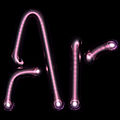General Chemistry/Chemistries of Various Elements/Group 18
Noble Gases
The noble gases are in Group 18 (8A). They are helium, neon, argon, krypton, xenon, and radon. They were once called inert gases because they were thought to be completely inert—unable to form compounds. This is a reasonable belief because the noble gases have a complete octet, making them very stable and unlikely to gain or lose any electrons. However, some compounds have been formed with the larger elements of this group, like xenon tetrafluoride (XeF4). No normal compounds of helium, neon, or argon are stable at any but the coldest of temperatures.
Radon is dangerously radioactive; it causes cancer. It is so unstable that its radioactivity makes any chemical experiments with it nearly impossible.
| Noble gases all have a complete octet (eight valence electrons), except for helium (which has only two electrons). Because this configuration is extremely stable as well as symmetrical, the noble gases are very unreactive. |
Ionization
If an electric current is passed through a gas, its electrons will become excited. The electron will jump to a higher energy level, but then it falls back down to a stable state and releases the energy that it had absorbed. The energy is released in the form of a photon, or particle of light. In other words, gases can be used to convert electricity into light—the concept of "neon signs". Neon signs are not necessarily filled with neon. They are filled with any mixture of gases to get the desired color. Each gas has a unique color that it emits.
- Colors of different noble gases when used in "neon" signs
Of course, other gases can be used besides the noble gases.
Helium
thumb|120px|Helium will not freeze. Instead, it becomes a superfluid.
Helium is a unique noble gas. It is the second most abundant element in the universe. Lighter than air, it is used in blimps because it will allow them to float without the risk of an explosion. Neon is the only element less reactive than helium.
Helium will not freeze under normal pressure. There cannot be enough intermolecular force to lock the atoms into a solid. It remains a gas until 4 K, then becomes a liquid. With the right conditions, helium becomes a superfluid. It is a liquid that will creep along the edges of its container with zero viscosity.
Helium atoms (they do not combine with other atoms) are too light to remain in the Earth's atmosphere. Almost all of the small amount of helium on Earth is the result of radioactive decay of very heavy elements like thorium and uranium.
Neon
Neon is best known for its presence in neon lights. The brightly-colored fish known as neon tetras are named for having a reddish color similar to that of a neon light, and not for possessing or using neon.




